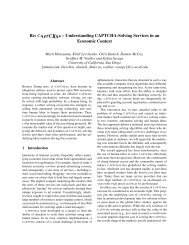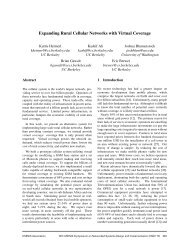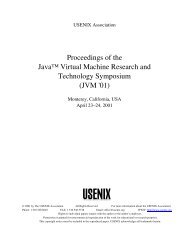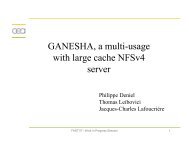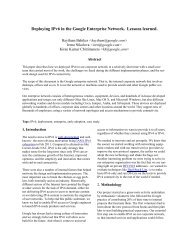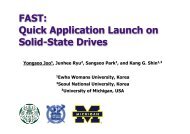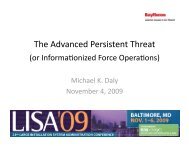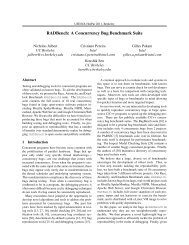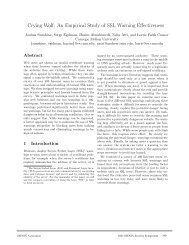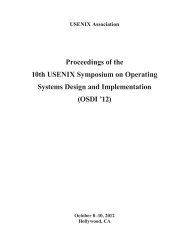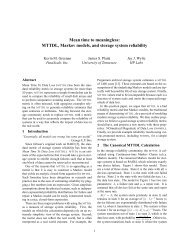Ext4: The Next Generation of Ext2/3 Filesystem - Usenix
Ext4: The Next Generation of Ext2/3 Filesystem - Usenix
Ext4: The Next Generation of Ext2/3 Filesystem - Usenix
Create successful ePaper yourself
Turn your PDF publications into a flip-book with our unique Google optimized e-Paper software.
IBM Linux Technology Center<br />
<strong>Ext4</strong>: <strong>The</strong> <strong>Next</strong> <strong>Generation</strong> <strong>of</strong><br />
<strong>Ext2</strong>/3 <strong>Filesystem</strong><br />
Mingming Cao<br />
Suparna Bhattacharya<br />
Ted Tso<br />
IBM<br />
© 2007 IBM Corporation
Agenda<br />
IBM Linux Technology Center<br />
� Motivation for ext4<br />
� Why fork ext4?<br />
� What's new in ext4?<br />
� Planned ext4 features<br />
© 2006 IBM Corporation
IBM Linux Technology Center<br />
Motivation for ext4<br />
� 16TB filesystem size limitation (32bit block numbers)<br />
� Second resolution timestamps<br />
� 32,768 limit on subdirectories<br />
� Performance limitations<br />
© 2006 IBM Corporation
Why fork ext4<br />
IBM Linux Technology Center<br />
� Many features require ondisk format changes<br />
� Keep large ext3 user community unaffected<br />
� Allows more experimentation than if the work is done outside <strong>of</strong><br />
mainline<br />
� Make sure users understand that ext4 is risky: mount t ext4dev<br />
� Downsides<br />
� bug fixes must be applied to two code bases<br />
� smaller testing community<br />
© 2006 IBM Corporation
IBM Linux Technology Center<br />
What's new in ext4<br />
� <strong>Ext4</strong> was cloned and included in 2.6.19<br />
� Replacing indirect blocks with extents<br />
� Ability to address >16TB filesystems (48 bit block numbers)<br />
� Use new forked 64bit JBD2<br />
© 2006 IBM Corporation
0<br />
1<br />
...<br />
...<br />
11<br />
12<br />
13<br />
14<br />
i_data<br />
200<br />
201<br />
...<br />
...<br />
211<br />
212<br />
1237<br />
65530<br />
IBM Linux Technology Center<br />
direct block<br />
indirect block<br />
double indirect block<br />
triple indirect block<br />
<strong>Ext2</strong>/3 Indirect Block Map disk blocks<br />
213<br />
...<br />
1236<br />
1238<br />
...<br />
...<br />
65531<br />
...<br />
...<br />
1239<br />
...<br />
...<br />
65532<br />
...<br />
...<br />
65533<br />
...<br />
...<br />
0<br />
...<br />
...<br />
200<br />
201<br />
...<br />
...<br />
213<br />
...<br />
...<br />
...<br />
...<br />
1239<br />
...<br />
...<br />
...<br />
65533<br />
...<br />
...<br />
© 2006 IBM Corporation
Extents<br />
IBM Linux Technology Center<br />
� Indirect block maps are incredibly inefficient for large files<br />
� One extra block read (and seek) every 1024 blocks<br />
� Really obvious when deleting big CD/DVD image files<br />
� An extent is a single descriptor for a range <strong>of</strong> contiguous blocks<br />
� a efficient way to represent large file<br />
� Better CPU utilization, fewer metadata IOs<br />
logical length physical<br />
0 1000 200<br />
© 2006 IBM Corporation
IBM Linux Technology Center<br />
Ondisk extents format<br />
� 12 bytes ext4_extent structure<br />
� address 1EB filesystem (48 bit physical block number)<br />
� max extent 128MB (15 bit extent length)<br />
� address 16TB file size (32 bit logical block number)<br />
struct ext4_extent {<br />
__le32 ee_block; /* first logical block extent covers */<br />
__le16 ee_len; /* number <strong>of</strong> blocks covered by extent */<br />
__le16 ee_start_hi; /* high 16 bits <strong>of</strong> physical block */<br />
__le32 ee_start; /* low 32 bits <strong>of</strong> physical block */<br />
};<br />
© 2006 IBM Corporation
IBM Linux Technology Center<br />
i_data<br />
header<br />
0<br />
1000<br />
200<br />
1001<br />
2000<br />
6000<br />
...<br />
...<br />
Extent Map disk blocks<br />
200<br />
201<br />
...<br />
...<br />
1199<br />
...<br />
...<br />
...<br />
6000<br />
6001<br />
...<br />
...<br />
6199<br />
...<br />
...<br />
© 2006 IBM Corporation
Extents tree<br />
IBM Linux Technology Center<br />
� Up to 3 extents could stored in inode i_data body directly<br />
� Use a inode flag to mark extents file vs ext3 indirect block file<br />
� Convert to a BTree extents tree, for > 3 extents<br />
� Last found extent is cached inmemory extents tree<br />
© 2006 IBM Corporation
oot<br />
i_data<br />
IBM Linux Technology Center<br />
Extent Tree<br />
header<br />
0<br />
extents<br />
extents index<br />
node header<br />
index node<br />
0<br />
...<br />
...<br />
leaf node disk blocks<br />
0<br />
...<br />
...<br />
...<br />
© 2006 IBM Corporation
IBM Linux Technology Center<br />
48bit block numbers<br />
� Part <strong>of</strong> the extents changes<br />
� 32bit ee_start and 16 bit ee_start_hi in ext4 extent struct<br />
� Why not 64bit<br />
� 48bit is enough for a 2**60 (or 1EB) filesystem<br />
� Original lustre extent patches provide 48bit block numbers<br />
� More packed meta data, less disk IO<br />
� Extent generation flag allow adapt to 64bit block number easily<br />
© 2006 IBM Corporation
IBM Linux Technology Center<br />
64bit meta data changes<br />
� In kernel block variables to address >32 bit block number<br />
� Super block fields: 32 bit > 64 bit<br />
� Larger block group descriptors (required doubling their size)<br />
� extended attributes block number (32 bit > 48 bit)<br />
© 2006 IBM Corporation
64bit JBD2<br />
IBM Linux Technology Center<br />
� Forked from JBD to handle 64bit block numbers<br />
� Could be used for 32bit journaling support as well<br />
� Added JBD2_FEATURE_INCOMPAT_64BIT<br />
© 2006 IBM Corporation
Testing ext4<br />
IBM Linux Technology Center<br />
� Mount it as ext4dev<br />
� mount t ext4dev<br />
� Enabling extents<br />
� mount t ext4dev o extents<br />
� compatible with the ext3 filesystem until you add a new file<br />
� ext4 vs ext3 performance<br />
� improve large file read/rewrite/unlink<br />
© 2006 IBM Corporation
Throughput(MB/sec)<br />
IBM Linux Technology Center<br />
Large File Sequential Read &Rewrite Using FFSB<br />
180<br />
160<br />
140<br />
120<br />
100<br />
80<br />
60<br />
40<br />
20<br />
0<br />
127<br />
153.7<br />
156.3<br />
166.3<br />
75.7<br />
102.7<br />
94.8<br />
Sequential Read Sequential rewrite<br />
100<br />
ext3<br />
ext4<br />
JFS<br />
XFS<br />
© 2006 IBM Corporation
IBM Linux Technology Center<br />
New defaults for ext4<br />
� Features available in ext3, enable by default in ext4<br />
� directory indexing<br />
� resize inode<br />
� large inode (256bytes)<br />
© 2006 IBM Corporation
IBM Linux Technology Center<br />
Planned new features for ext4<br />
� Workinprogress: patches available<br />
� More efficient multiple block allocation<br />
� Delayed block allocation<br />
� Persistent file allocation<br />
� Online defragmentation<br />
� Nanosecond timestamps<br />
© 2006 IBM Corporation
IBM Linux Technology Center<br />
Others planned features<br />
� Allow greater than 32k subdirectories<br />
� Metadata checksumming<br />
� Uninitialized groups to speed up mkfs/fsck<br />
� Larger file (16TB)<br />
� Extending Extended Attributes limit<br />
� Caching directory contents in memory<br />
© 2006 IBM Corporation
IBM Linux Technology Center<br />
And maybe scales better?<br />
� 64 bit inode number<br />
� challenge: user space might in trouble using 32bit stat()<br />
� Dynamic inode table<br />
� More scalable free inode/free block scheme<br />
� fsck scalability issue<br />
� Larger block size<br />
© 2006 IBM Corporation
IBM Linux Technology Center<br />
Multiple block allocation<br />
� Multiple block allocation<br />
� Allocate contiguous blocks together<br />
– Reduce fragmentation, extent metadata and cpu usage<br />
– Stripe aligned allocations<br />
� Buddy free extent bitmap generated from ondisk bitmap<br />
� Status<br />
� Patch available<br />
© 2006 IBM Corporation
IBM Linux Technology Center<br />
Delayed block allocation<br />
� Defer block allocation to write back time<br />
� Improve chances allocating contiguous blocks, reducing fragmentation<br />
� Blocks are reserved to avoid ENOSPC at writeback time:<br />
� At prepare_write() time, use page_private to flag page need block<br />
reservation later.<br />
� At commit_write() time, reserve block. Use PG_booked page flag to<br />
mark disk space is reserved for this page<br />
� Trickier to implement in ordered mode<br />
© 2006 IBM Corporation
Throughput(MB/sec)<br />
110<br />
100<br />
90<br />
80<br />
70<br />
60<br />
50<br />
40<br />
30<br />
20<br />
10<br />
0<br />
IBM Linux Technology Center<br />
Large File Sequential Write Using FFSB<br />
71<br />
91.9<br />
Sequential write<br />
89.3<br />
104.3<br />
ext3<br />
ext4+del+mbl<br />
JFS<br />
XFS<br />
© 2006 IBM Corporation
IBM Linux Technology Center<br />
Persistent file preallocation<br />
� Allow preallocating blocks for a file without having to initialize them<br />
� Contiguous allocation to reduce fragmentation<br />
� Guaranteed space allocation<br />
� Useful for Streaming audio/video, databases<br />
� Implemented as uninitialized extents<br />
� MSB <strong>of</strong> ee_len used to flag “invalid” extents<br />
� Reads return zero<br />
� Writes split the extent into valid and invalid extents<br />
� API for preallocation<br />
� Current implementation uses ioctl<br />
�<br />
– EXT4_IOC_FALLOCATE cmd, the <strong>of</strong>fset and bytes to preallocate<br />
© 2006 IBM Corporation
IBM Linux Technology Center<br />
Online defragmentation<br />
� Defragmentation is done in kernel, based on extent<br />
� Allocate more contiguous blocks in a temporary inode<br />
� Read a data block form the original inode, move the corresponding<br />
block number from the temporary inode to the original inode, and<br />
write out the page<br />
� Join the ext4 online defragmentation talk for more detail<br />
© 2006 IBM Corporation
IBM Linux Technology Center<br />
Expanded inode<br />
� Inode size is normally 128 bytes in ext3<br />
� But can be 256, 512, 1024, etc. up to filesystem blocksize<br />
� Extra space used for fast extended attributes<br />
� 256 bytes needed for ext4 features<br />
� Nanosecond timestamps<br />
� Inode change version # for Lustre, NFSv4<br />
© 2006 IBM Corporation
IBM Linux Technology Center<br />
High resolution timestamps<br />
� Address NFSv4 needs for more fine granularity time stamps<br />
� Proposed solution used 30 bits out <strong>of</strong> the 32 bits field in larger<br />
inode (>128 bytes) for nanoseconds<br />
� Performance concern: result in additional dirtying and writeout<br />
updates<br />
� might batched by journal<br />
© 2006 IBM Corporation
IBM Linux Technology Center<br />
Unlimited number <strong>of</strong> subdirectories<br />
� Each subdirectory has a hard link to its parent<br />
� Number <strong>of</strong> subdirectories under a single directory is limited by type<br />
<strong>of</strong> inode's link count(16 bit)<br />
� Proposed solution to overcome this limit:<br />
� Not counting the subdirectory limit after counter overflow,<br />
storing link count <strong>of</strong> 1 instead.<br />
© 2006 IBM Corporation
IBM Linux Technology Center<br />
Metadata checksuming<br />
� Pro<strong>of</strong> <strong>of</strong> concept implementation described in the Iron <strong>Filesystem</strong><br />
paper (from University <strong>of</strong> Wisconsin)<br />
� Storage trends: reliability and seek times not keeping up with<br />
capacity increases<br />
� Add checksums to extents, superblock, block group descriptors,<br />
inodes, journal<br />
© 2006 IBM Corporation
IBM Linux Technology Center<br />
Uninitialized block groups<br />
� Add flags field to indicate whether or not the inode and bitmap<br />
allocation bitmaps are valid<br />
� Add field to indicate how much <strong>of</strong> the inode table has been<br />
initialized<br />
� Useful to create a large filesystem and fsck a notveryfull large<br />
filesystem<br />
© 2006 IBM Corporation
IBM Linux Technology Center<br />
Extend EA limit<br />
� Allow EA data larger than a single filesystem block<br />
� <strong>The</strong> last entry in EA block is reserved to point to a small number <strong>of</strong><br />
extra EA data blocks, or to an indirect block<br />
© 2006 IBM Corporation
IBM Linux Technology Center<br />
ext3 vs ext4 summary<br />
ext3 ext4dev<br />
filesystem limit 16TB 1EB<br />
file<br />
number<br />
limit<br />
<strong>of</strong> files<br />
2TB 16TB<br />
limit<br />
2**32 2**32<br />
default inode size 128 bytes 256 bytes<br />
block mapping indirect block map extents<br />
time stamp second nanosecond<br />
sub dir limit 2**16 unlimited<br />
EA limit 4K >4K<br />
preallocation incore reservation for extent file<br />
deframentation No yes<br />
directory indexing disabled enabled<br />
delayed allocation No yes<br />
multiple block<br />
allocation<br />
basic advanced<br />
© 2006 IBM Corporation
IBM Linux Technology Center<br />
Getting involved<br />
� Mailing list: linuxext4@vger.kernel.org<br />
� latest ext4 patch series<br />
ftp://ftp.kernel.org/pub/linux/kernel/people/tytso/ext4patches<br />
� Wiki: http://ext4.wiki.kernel.org<br />
� Still needs work; anyone want to jump in and help, talk to us<br />
� Weekly conference call; minutes on the wiki<br />
� Contact us if you'd like dial in<br />
� IRC channel: irc.<strong>of</strong>tc.net, /join #linuxfs<br />
© 2006 IBM Corporation
IBM Linux Technology Center<br />
<strong>The</strong> <strong>Ext4</strong> Development Team<br />
� Alex Thomas<br />
� Andreas Dilger<br />
� <strong>The</strong>odore Tso<br />
� Stephen Tweedie<br />
� Mingming Cao<br />
� Suparna Bhattacharya<br />
� Dave Kleikamp<br />
� Badari Pulavarathy<br />
� Avantikia Mathur<br />
� Andrew Morton<br />
� Laurent Vivier<br />
� Alexandre Ratchov<br />
� Eric Sandeen<br />
� Takashi Sato<br />
� Amit Arora<br />
� JeanNoel Cordenner<br />
� Valerie Clement<br />
© 2006 IBM Corporation
Conclusion<br />
IBM Linux Technology Center<br />
� <strong>Ext4</strong> work just beginning<br />
� Extents merged, other patches on deck<br />
© 2006 IBM Corporation
IBM Linux Technology Center<br />
Legal Statement<br />
This work represents the view <strong>of</strong> the authors and does not necessarily represent the view <strong>of</strong><br />
IBM.<br />
IBM and the IBM logo are trademarks or registered trademarks <strong>of</strong> International Business<br />
Machines Corporation in the United States and/or other countries.<br />
Lustre is a trademark <strong>of</strong> Cluster File Systems, Inc.<br />
Unix is a registered trademark <strong>of</strong> <strong>The</strong> Open Group in the United States and other countries.<br />
Linux is a registered trademark <strong>of</strong> Linus Torvalds in the United States, other countries, or both.<br />
Other company, product, and service names may be trademarks or service marks <strong>of</strong> others<br />
References in this publication to IBM products or services do not imply that IBM intends to<br />
make them available in all countries in which IBM operates.<br />
This document is provied ``AS IS,'' with no express or implied warranties. Use the information in<br />
this document at your own risk.<br />
© 2006 IBM Corporation



